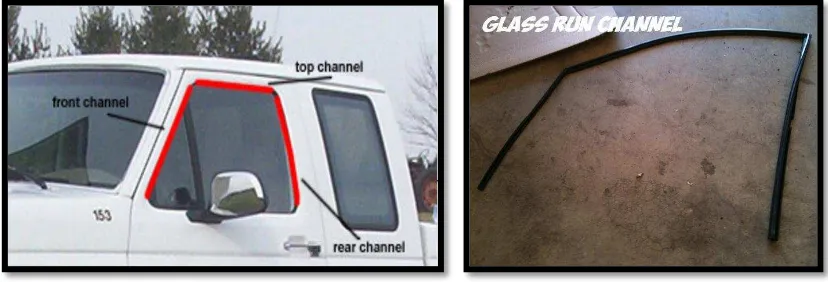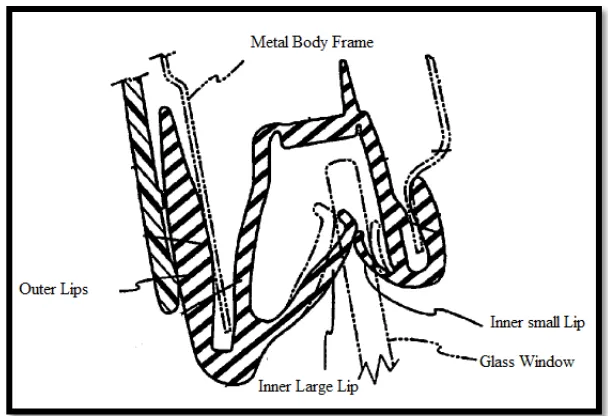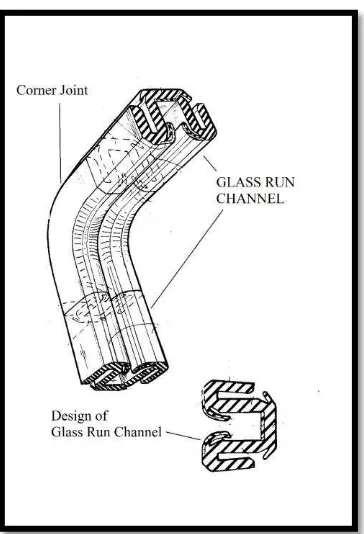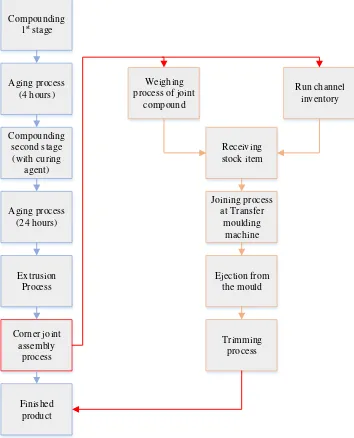UNIVERSITI TEKNIKAL MALAYSIA MELAKA
INVESTIGATION OF DEFECTS IN TRANSFER MOULDING
PROCESS OF THE AUTOMOTIVE GLASS RUN CHANNEL
SPECIFICALLY FOR THE CORNER JOINT
This report submitted in accordance with requirement of the Universiti Teknikal Malaysia Melaka (UTeM) for the Bachelor Degree in Manufacturing Engineering
Technology (Process & Technology) (Hons.)
by
MOHD SYAHIRAN BIN SARAMUDIN
B071110277
910309-02-5197
TAJUK: Investigation of Defects in Transfer Moulding Process of the Automotive Glass Run Channel Specifically for the Corner Joint
SESI PENGAJIAN: 2014/15 Semester 1
Saya MOHD SYAHIRAN BIN SARAMUDIN
mengaku membenarkan Laporan PSM ini disimpan di Perpustakaan Universiti Teknikal Malaysia Melaka (UTeM) dengan syarat-syarat kegunaan seperti berikut:
1. Laporan PSM adalah hak milik Universiti Teknikal Malaysia Melaka dan penulis. 2. Perpustakaan Universiti Teknikal Malaysia Melaka dibenarkan membuat salinan
untuk tujuan pengajian sahaja dengan izin penulis.
3. Perpustakaan dibenarkan membuat salinan laporan PSM ini sebagai bahan pertukaran antara institusi pengajian tinggi. atau kepentingan Malaysia sebagaimana yang termaktub dalam AKTA RAHSIA RASMI 1972)
(Mengandungi maklumat TERHAD yang telah ditentukan oleh organisasi/badan di mana penyelidikan dijalankan)
Alamat Tetap:
Tarikh: ________________________
Disahkan oleh:
UNIVERSITI TEKNIKAL MALAYSIA MELAKA
BORANG PENGESAHAN STATUS LAPORAN PROJEK SARJANA MUDA
Cop Rasmi:
Tarikh: _______________________
DECLARATION
I hereby, declared this report entitled “Investigation of Defects in Transfer Moulding Process of the Vehicle Glass Run Channel Specifically for the Corner
Joint” is the results of my own research except as cited in references.
Signature : ……….
Author’s Name : Mohd Syahiran bin Saramudin
Matric No. : B071110277
APPROVAL
This report is submitted to the Faculty of Engineering Technology of UTeM as a partial fulfillment of the requirements for the degree of Bachelor of Manufacturing Engineering Technology (Process & Technology) (Hons.). The member of the supervisory is as follow:
FAKULTI KEJURUTERAAN PEMBUATAN
PENGKELASAN LAPORAN PSM SEBAGAI SULIT/TERHAD LAPORAN PROJEK SARJANA MUDA TEKNOLOGI KEJURUTERAAN PEMBUATAN (PROSES & TEKNOLOGI): MOHD SYAHIRAN BIN SARAMUDIN
Sukacita dimaklumkan bahawa Laporan PSM yang tersebut di atas bertajuk
“Investigation of Defects in Transfer Moulding Process of the Vehicle Glass Run Channel Specifically for the Corner Joint” mohon dikelaskan sebagai *SULIT / TERHAD untuk tempoh LIMA (5) tahun dari tarikh surat ini.
2. Hal ini adalah kerana IANYA MERUPAKAN PROJEK YANG DITAJA OLEH SYARIKAT LUAR DAN HASIL KAJIANNYA ADALAH SULIT.
Sekian dimaklumkan. Terima kasih.
Yang benar,
________________
ABSTRAK
ABSTRACT
DEDICATION
ACKNOWLEDGEMENT
TABLE OF CONTENT
2.2.4 Chemical Additives of Glass Run Channel 8
2.3 Extrusion Process 11
2.3.1 Principle of Extrusion 11
2.3.2 Continuous Vulcanisation 12
2.3.3 Extrusion Die 13
2.4 Transfer Moulding Process & Defects 14
2.4.1 Introduction to Transfer Moulding 14
2.4.2 Defects on Glass Run Channel 15
2.4.2.1 Factor That Causes Short Moulding Defects 16 2.4.2.2 Factor That Causes Bubble Defects 18
2.4.3 Elimination of Defects 20
2.5 Previous Research 21
CHAPTER 3: METHODOLOGY 24
3.1 Introduction 24
3.1.1 Methodology of Project 26
3.2 Investigation of Root Cause 27
3.2.1 Man Factor Contribution to Defects 28
3.2.2 Method Factor Contribution to Defects 29
3.2.3 Machine Factor Contribution to Defects 30
3.2.4 Material Factor Contribution to Defects 31
3.3 Plan for Data Gathering 32
3.3.1 Observation on Man Factor 32
3.3.2 Observation on Method Factor 33
3.3.3 Observation on Machine Factor 34
3.3.4 Observation on Material Factor 35
3.4 Data Gathering 36
3.4.1 Data Interpretation for the Man Factor 36
3.6 Recommend the Solution 41
3.7 Suggest Improvement Made 41
CHAPTER 4: RESULT & DISCUSSION 42
4.1 Result for Man Factor 42
4.2 Result for Method Factor 46
4.2.1 Observation on Transfer Moulding Process 46 4.2.1 Observation on Joint Compound Weighing Process 50
4.3 Result for machine Factor 52
4.3.1 Process Capability Ratio for Mould Temperature 54 4.3.2 Process Capability Ratio for Injector Pressure 55
4.4 Result for Material Factor 56
4.4.1 Observation on Specific Gravity test 56
4.4.2 Observation on Joint Compound Weight Sample 58 4.5 Suggestion on Improvement Should Made by the Company 59
4.5.1 Improvement Suggestion to Man Factor 59
4.5.2 Improvement Suggestion to Method Factor 61
CHAPTER 5: CONCLUSION & RECOMMENDATION 62
5.1 Conclusion 62
5.2 Recommendation 63
REFERENCE 64
LIST OF TABLES
3.1 Performance study data sheet of man factor 32
3.2 Data in transfer moulding process of machine factor 34 3.3 Specific gravity and joint compound weight of glass run channel 35
4.1 Summarized performance percentage of operator from month January
to June 2014 43
4.2 Process capability of mould temperature for all machine 54 4.3 Process capability of injector pressure for all machine 55 4.4 Mean, standard deviation and control limit for specific gravity test 57 4.5 Mean, standard deviation and control limit for sample of joint
LIST OF FIGURES
2.1 Example Application of glass run channel 5
2.2 Cross section of Glass Run Channel 6
2.3 Corner Joint of glass run channel 7
2.4 Manufacturing process flow of glass run channel 9 2.5 The schematic diagram of extrusion moulding machine 11
2.6 Example of continuous vulcanisation process 12
2.7 Example of die in Rubber Extrusion 13
2.8 Component of transfer moulding machine 14
2.9 Example bubble and short moulding as defective product 15
3.1 Methodology of Project 26
3.2 Ishikawa Diagram of bubble and short moulding defects
for glass run channel corner joint. 27
3.3 Ishikawa diagram of man factor 28
3.4 Ishikawa diagram of method factor 29
3.5 Ishikawa diagram of machine factor 30
3.6 Ishikawa diagram of material 31
3.7 Bar graph to interpretation data of man factor 36 3.8 Flow chart to interpretation data from joining process of method factor 37 3.9 Flow chart to interpretation data from compound weighing process of
method factor 38
3.10 Control chart to interpretation data from machine factor 39 3.11 Control chart to interpretation data from machine factor 40
4.1 The bar graph of average performance percentage of the operator 44 4.2 The line graph of performance percentage for operator
at machine No. 5 45
4.5 Average mould temperature and injector pressure for machine 1to 6
within six month of operation 52
1
CHAPTER 1
INTRODUCTION
In this chapter will discuss on the project background, problem statement, objectives and scopes of the project.
1.1 Background
Automotive glass run channel is widely used in various kinds of vehicle since it's been introduced in earlier 1900’s as a weather strip component. The function the run channel is to prevent rain or water entering the vehicle completely, and also to keep interior air conditioning at a comfortable temperature. Mainly, the function of the glass run channel is to provide motion guidance for glass window of a vehicle and as a seal component that will prevent from extensive outside environment. Glass run channel is made of EPDM rubber (ethylene, propylene, diene, M- class rubber) which is known as thermoplastic elastomer material or synthetic material. This synthetic rubber which has outstanding properties on temperature, weather fluctuations, tensile strength, and resistance to chemical and also act as electrical insulators, where do it chosen as good material of sealing capability of the glass run channel.
2 moulding machine. During this assembly process, there are several quality issues occurred on glass run channel which is bubble and short moulding. This kind of defects have led the production system inefficient and lowering the productivity of the company.
1.2 Problem Statement
Quality issue regarding to the corner joint defects in glass run channel becomes a major concern for the assigned company. The defects cause the production system of the company to be less effective and decreasing and fail to meet customer requirement lead time. During corner joint assembly process of glass run channel, there are several types of defects occured in the process such as bubble, short moulding (incomplete moulding), dirty, sink mark, warpage and flow mark. This project will focus on investigation of the root cause that contribute to bubble and short moulding.
3 1.3 Objectives
Objectives this project are:
i. To identify the potential root cause that contribute to bubble and short moulding defects.
ii. To apply the root cause analysis based on the 4 influencing factor (man, method, machine, and material).
iii. To recommend the solution to solve the bubble and short moulding defects.
1.4 Project Scope
This project scope are described as below;
i. Glass run channel will be studied for this project. This project will be focused on to identify the root cause of two major types of defects that is bubble and short moulding.
ii. This project will be apply root cause analysis procedure based on four main influencing factor which are man, method, machine and material.
4
CHAPTER 2
LITERATURE REVIEW
2.1 Introduction
This chapter will provide the review of previous research which relates to this study. The review include the function of glass run channel, design and cross section. The process to manufacturing process involve in order to manufacture this product also will discussed on this section. The defects occur during transfer moulding process for the corner joint. The root cause of the defects involved on each factor and solution on how to reduce the defects are also described in this section.
2.2 About Glass Run Channel
5
2.2.1 Function of Glass Run Channel
Glass run channel is a seal opening at the side window of automotive vehicle while allowing glass sliding within the U-shape gap of the product. The product mainly in black in colour which is made from synthetic rubber such as EPDM rubber which has reliable physical and mechanical properties needed for a glass window. The sliding function of the glass window achieved by flocking and lips design to prevent abrasion of glass towards the glass run channel. Abrasion material are also added to the contact surface of a glass window with the run channel which able to remove the abrasive force of both contact surfaces. Application of the glass run channel can be seen in the Figure 2.1. (Hutchinson, 2010).
Figure 2.1: Example Application of glass run channel. (Ford 4WD, 2008)
2.2.2 Design of Glass Run Channel
6 the extruded longitudinal section of an upper, vertical and side portion of the door glass gap while fitting with the corners of the door frame. The exterior surface of glass run channel which contact with the surface of the door metal body is brought into force that attach to an interior surface of the glass run channel, thereby fix the glass run channel into position. The inner and outer holding lips help to seal gaps between the metal body frame and glass run channel at inner side and outer side wall. Vertical straight cross section and upper side straight cross section of the glass run channel are joined to the corner section compound, thereby ensuring sealing properties and strongly secured to the door frame. (Tomoki Ota, 2012)
7 Figure 2.3: Corner Joint of glass run channel. (Kohji.Y, 1998)
2.2.3 Material of Glass Run Channel
8
2.2.4 Chemical Additives in Glass Run Channel Compound
To achieve the rubber desired range and properties, is added with some additives. There are example of additives that mix with synthetic rubber which are described as below;
a) Curatives – A chemical that actively creates internal bonding which is cross link of the long chain polymer such as sulphur.
b) Accelerators – A chemical that increases the rate of reaction for the curing process c) Reinforcing filler – A material which increase the mechanical properties of a rubber,
especially the strength of the product. Example material been used is carbon Black and silica.
d) Filler – Inert chemical such as clay that increase the bulk of the compound.
e) Plasticisers – To increase the process ability of the compound to produce specified product.
f) Anti – Oxidant – A chemical which added to help compound durability from ozone. (James A. Roth, 2009)
2.2.5 Manufacturing Process of Glass Run Channel
9



